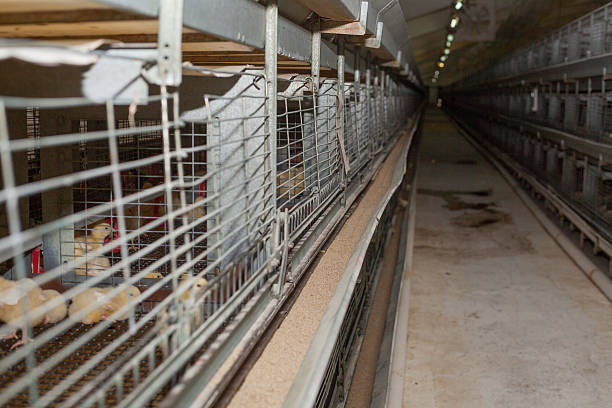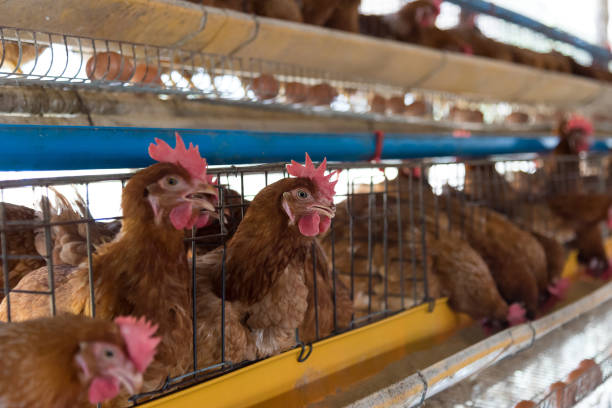Galvanized Poultry Cages: The Durable Solution for African Chicken Farmers
Galvanized Poultry Cages: The Durable Solution for African Chicken Farmers
For chicken farmers across Africa, efficiency and durability are paramount to building a sustainable and profitable business. In the face of challenging climates, fluctuating market prices, and the ever-present need to optimize resources, selecting the right poultry housing solution becomes a critical decision. Galvanized poultry cages offer a blend of robustness, longevity, and cost-effectiveness that makes them an increasingly popular choice for farmers looking to enhance their operations. This article will delve into the benefits, types, application, maintenance and considerations of galvanized poultry cages, demonstrating why they represent a durable solution well-suited for the unique demands of African chicken farming.
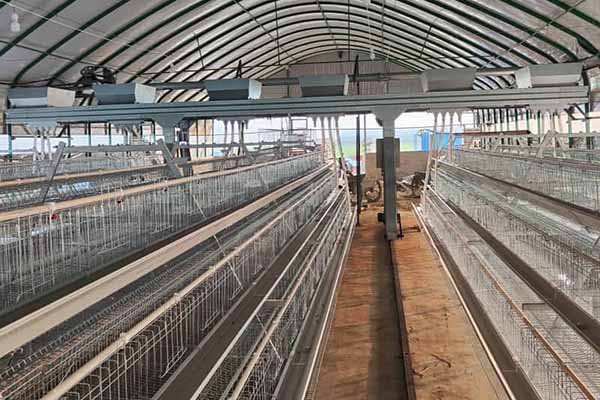
What are Galvanized Poultry Cages?
Galvanized poultry cages are essentially wire mesh enclosures treated with a protective layer of zinc. This process, known as galvanization, is crucial because it prevents rust and corrosion – major threats to metal structures, particularly in humid or variable weather conditions commonly found in many parts of Africa. The cage construction materials are typically steel, offering high strength and stability. After fabrication, the cages are submerged in molten zinc or electroplated with zinc, creating a bonded coating that shields the steel from the elements.
Why Galvanization Matters for African Chicken Farmers
Africa’s diverse climate ranges from scorching deserts to humid rainforests, and these environmental conditions can quickly deteriorate unprotected metal. Traditional steel cages are prone to rusting, which weakens the structure, shortens the lifespan of the cages, and poses a health hazard to the chickens. The zinc coating provided by galvanization acts as a barrier, preventing moisture and oxygen from reaching the steel and causing corrosion.
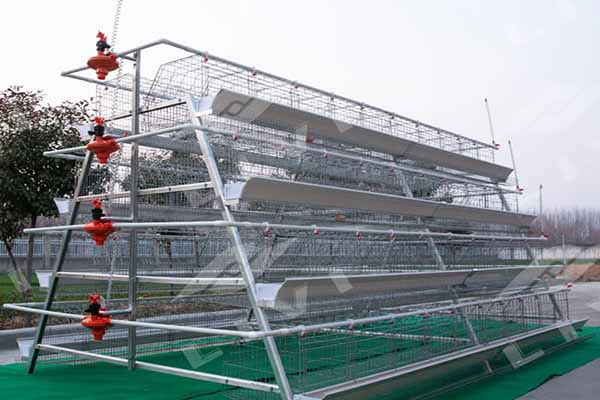
Beyond the protective aspect, galvanized coatings are also remarkably durable. They withstand scratches and abrasions better than many other protective coatings, making them suitable for the constant wear and tear associated with poultry farming. This durability translates to fewer replacements, lower maintenance costs, and a more reliable infrastructure for chicken farmers.
The Key Benefits of Galvanized Poultry Cages
For African chicken farmers, the advantages of galvanized poultry cages are numerous:
Extended Lifespan: Galvanization significantly extends the life of the cages, reducing the need for frequent replacements. This is a crucial cost-saving factor, especially for small and medium-sized farms with limited capital.
Corrosion Resistance: The zinc coating acts as a sacrificial layer, corroding before the steel beneath. This is particularly important in humid or coastal regions where rust is a major problem.
Reduced Maintenance: Galvanized cages require minimal maintenance, saving time and labor costs. Regular cleaning is usually sufficient to keep them in good condition.
Improved Hygiene: The smooth surface of galvanized wire is easy to clean and disinfect, minimizing the risk of bacterial growth and disease outbreaks. This contributes to a healthier environment for the chickens, reducing mortality rates and improving overall productivity.
Enhanced Bird Welfare: Well-designed galvanized cages provide adequate space and ventilation for the chickens, contributing to their well-being. Features like sloped floors and egg collection systems can further improve bird welfare and egg quality.
Cost-Effectiveness: While the initial investment in galvanized cages may be slightly higher than non-galvanized options, the long lifespan and reduced maintenance costs make them a more cost-effective solution in the long run.
Increased Productivity: By providing a clean, safe, and comfortable environment for the chickens, galvanized cages can help to improve egg production and broiler growth rates.
Pest and Predator Control: The sturdy construction of galvanized cages provides a barrier against rodents, snakes, and other predators, protecting the chickens from harm.
Easy to Assemble: Galvanized cages are designed for easy assembly and installation, which saves time and labor costs. They can be quickly set up and taken down as needed.
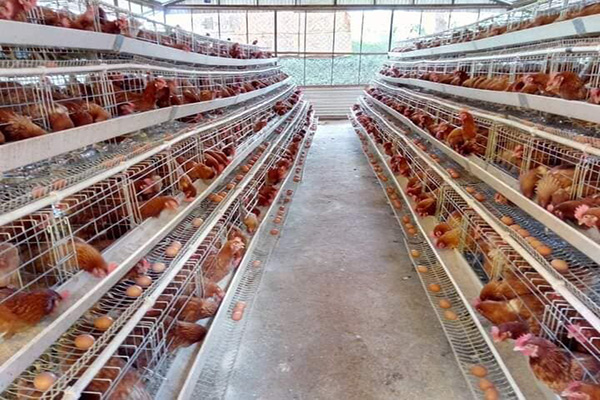
Types of Galvanized Poultry Cages
Galvanized poultry cages come in various designs to suit different farming needs and chicken breeds. The main types include:
Layer Cages: Typically used for egg-laying hens, these cages are designed to maximize egg production. They feature sloped floors for easy egg collection and feeders and waterers that are easily accessible to the birds. Layer cages can be stacked in multiple tiers to maximize space utilization.
Broiler Cages: Designed for raising meat chickens (broilers), these cages are built to accommodate the rapid growth of the birds. They often have larger floor spaces than layer cages and are designed for easy cleaning and waste removal.
Chick Cages: Used for raising young chicks, these cages provide a safe and warm environment for the birds to grow. They typically have smaller mesh sizes to prevent chicks from escaping and are equipped with heating lamps or other temperature control devices.
Breeder Cages: Designed for breeding chickens, these cages provide a separate space for hens and roosters to mate. They are often equipped with nesting boxes and other features that promote breeding success.
A-Frame Cages: This is the most common type of cage which can hold plenty of chickens inside.
The galvanization method also varies, resulting in different types of coatings:
Hot-Dip Galvanized: This method involves immersing the finished cage in a bath of molten zinc, resulting in a thick, durable coating that provides excellent corrosion protection. Hot-dip galvanizing is ideal for cages that will be exposed to harsh environments.
Electro-Galvanized: This method uses an electric current to deposit a thin layer of zinc onto the steel. Electro-galvanized coatings are less durable than hot-dip galvanized coatings but are more aesthetically pleasing. They are suitable for indoor use or in areas with mild climates.
Application of Galvanized Poultry Cages
Galvanized poultry cages are versatile and can be used in a variety of farming setups:
Small-Scale Farms: For small farmers with limited land, galvanized cages provide an efficient way to raise chickens in a confined space. The cages can be easily arranged in rows or stacks to maximize space utilization.
Medium-Scale Farms: Medium-sized farms can use galvanized cages to house larger flocks of chickens. The cages can be arranged in multiple rows and tiers to increase production capacity.
Large-Scale Commercial Farms: Large-scale farms rely on galvanized cages to house thousands of chickens. The cages are typically automated with feeding, watering, and egg collection systems to minimize labor costs and maximize efficiency.
Backyard Poultry: Even for backyard chicken keepers, galvanized cages can be a convenient way to protect chickens from predators and provide a controlled environment.
How to Choose the Right Galvanized Poultry Cages
Selecting the right galvanized poultry cages requires careful consideration of several factors:
Cage Size: The size of the cage should be appropriate for the number of chickens being housed. Overcrowding can lead to stress and disease.
Wire Gauge: The wire gauge should be strong enough to withstand the weight of the chickens and resist damage from predators.
Mesh Size: The mesh size should be small enough to prevent chicks from escaping but large enough to allow for adequate ventilation.
Galvanization Method: The galvanization method should be appropriate for the environment in which the cages will be used. Hot-dip galvanized cages are recommended for harsh environments, while electro-galvanized cages are suitable for indoor use or mild climates.
Cage Design: The cage design should be conducive to good hygiene and bird welfare. Features like sloped floors, egg collection systems, and easy-to-clean surfaces are desirable.
Manufacturer Reputation: Choose a reputable manufacturer with a track record of producing high-quality galvanized poultry cages. Look for companies that offer warranties and provide excellent customer service.
Budget: Consider your budget and choose cages that offer the best value for your money. While it’s important to save money, it’s also important to invest in durable, high-quality cages that will last for many years.
Local Climate: Consider the local climate and choose cages that are designed to withstand the environmental conditions in your area. In hot climates, choose cages with good ventilation. In humid climates, choose cages with a durable galvanized coating.
Chicken Breed: Consider the breed of chicken you are raising and choose cages that are appropriate for the size and behavior of the birds. For example, larger breeds of chickens require larger cages.
Maintaining Galvanized Poultry Cages
While galvanized poultry cages are known for their durability, proper maintenance is essential to prolong their lifespan and maintain a healthy environment for the chickens:
Regular Cleaning: Clean the cages regularly to remove manure, feathers, and other debris. Use a brush or scraper to remove caked-on material and disinfect the cages with a poultry-safe disinfectant.
Inspection: Inspect the cages regularly for signs of rust or damage. Repair any damaged areas promptly to prevent further deterioration.
Lubrication: Lubricate the moving parts of the cages, such as doors and hinges, with a light oil to prevent them from seizing up.
Environmental Control: Ensure that the cages are protected from extreme weather conditions, such as heavy rain or direct sunlight. Consider providing shade or shelter to protect the chickens from the elements.
Rodent Control: Implement a rodent control program to prevent rodents from damaging the cages.
Vegetation Control: Keep the area around the cages free of vegetation to prevent moisture buildup and pest infestations.
The Future of Galvanized Poultry Cages in Africa
As the demand for poultry products continues to grow in Africa, galvanized poultry cages are poised to play an increasingly important role in the development of sustainable and efficient farming practices. With their durability, cost-effectiveness, and ability to improve bird welfare, galvanized cages offer a compelling solution for farmers looking to enhance their operations.
Technological advancements are also driving innovation in the design and manufacturing of galvanized poultry cages. Automated feeding, watering, and egg collection systems are becoming increasingly common, reducing labor costs and improving efficiency. Precision farming techniques are also being used to optimize cage layouts and environmental control, maximizing productivity and minimizing waste.
Furthermore, there is growing awareness of the importance of sustainable farming practices in Africa. Farmers are increasingly adopting cage systems that promote animal welfare, reduce environmental impact, and improve the overall sustainability of their operations. Galvanized poultry cages, with their long lifespan and minimal maintenance requirements, are well-suited for these sustainable farming practices.
Common Misconceptions about Galvanized Poultry Cages
Some people worry about the safety of galvanized cages, fearing that the chickens might ingest zinc and suffer health problems. However, properly galvanized cages are considered safe for poultry. The zinc coating is tightly bonded to the steel and is not easily ingested by the birds. Additionally, chickens require small amounts of zinc in their diet for optimal health, and the amount of zinc they might ingest from the cages is typically negligible.
Another misconception is that galvanized cages are too expensive for small-scale farmers. While the initial investment may be higher than non-galvanized options, the long lifespan and reduced maintenance costs make them a more cost-effective solution in the long run. Additionally, there are financing options available to help small-scale farmers purchase galvanized poultry cages.
Conclusion
Galvanized poultry cages represent a durable, cost-effective, and sustainable solution for African chicken farmers. Their ability to withstand harsh climates, resist corrosion, and minimize maintenance makes them an ideal choice for farmers looking to enhance their operations and improve bird welfare. By carefully selecting the right type of cage, implementing proper maintenance practices, and staying informed about technological advancements, African chicken farmers can leverage the benefits of galvanized poultry cages to build successful and sustainable businesses that contribute to food security and economic growth in the region. The resilience and longevity of these cages ensure that farmers can focus on what matters most: raising healthy, productive chickens and providing a reliable source of food for their communities.




